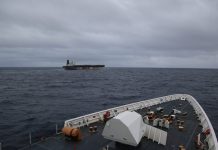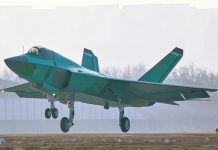A modernized Su-57 stealth fighter jet took to the skies on its maiden flight on October 21, 2022, at Zhukovsky flight test center near Moscow, the United Aircraft Corporation (UAC) announced on October 25, 2022.
According to UAC, the aircraft was piloted by a test pilot of the Sukhoi Experimental Design Bureau, Sergey Bogdan. The 56 minutes test flight was incident free.
“A set of onboard equipment with extended functionality, intelligent crew support, and the possibility of using a wide range of new weapons is being tested on the aircraft. It is also possible to install the engine of the second stage on the aircraft,” the press service said.
Intelligent Crew Support
Intelligent crew support allows the Su-57’s onboard computer to perform copiloting tasks, freeing the pilot to focus on critical functions. The aircraft takes over piloting and preparing the use of weapons, according to Yuri Slyusar, Director General of the UAC. The aircraft also features a high degree of intelligent automation in combat.
On July 28, 2021, Nikita Dorofeev, head of the cockpit department of the Sukhoi Design Bureau, said that in the future, a Su-57 pilot would be able to control the plane with eye movements or voice. Despite the complexity of such a system, since the human pupil is constantly moving unconsciously, its prototype already exists, Dorofeev pointed out.
Also, at present, the task is to teach the system to understand not learned phrases, but the context, so that in extreme conditions, “the pilot does not need to remember exactly which phrase he should pronounce.”
According to Rafael Suleimanove, test pilot of the Sukhoi Design Bureau, the Intelligent Crew Support allows the Su-57 to “perform everything in the air.”
“Piloting this aircraft is very pleasant and comfortable. It allows you to perform everything in the air. These capabilities, coupled with powerful weapons that allow you to perform tasks both in the air and on the ground, in any weather conditions, day and night, in any latitudes, make it a potent weapon in the hands of the pilots,” said the test pilot.
Suleimanov also noted that the generations of Su aircraft are very similar. Pilots who fly the Su-35 can easily fly the fifth-generation fighter.
Stage 2 Engine
When originally conceived, the Su-57 was envisaged to be powered by a clean sheet design new engine referred to as Izdeliye (Product) 30, which would enable it to cruise at supersonic speed without the use of gas-guzzling afterburners.
The aircraft was, however, developed and tested using an interim power plant – NPO Saturn Product 117 engine, which is derived from the AL-41F-1S after-burning turbofans developed for the Su-35.
The Izdeliye 30 will improve the thrust and fuel efficiency of the fighter and reduce weight and maintenance requirements.
The Izdeliye 30 engine was first flight tested on December 5, 2017. Since then, the engine has undergone intensive flight testing. As of October 2019, the engine had undergone 16 flight tests on a modified Su-57.
In December 2019, Izvestia quoted Yuri Slyusar, general director of the UAC, saying that the Stage 2 engine was undergoing intensive testing. The engine had been flight tested for thrust vectoring, and its oil system had been tested under adverse flight conditions. Bench testing of the engine, too, was ongoing.
A Sukhoi Design Bureau employee told TASS in September 2022 that, unlike 4th-gen fighters, the Su-57 can maintain supersonic speeds during most of its mission profile, even when engaged in combat.
“If a fourth-generation aircraft lives at subsonic speeds most of the time and goes to perform specific combat missions at supersonic flight speeds, then this aircraft (Su-57) is designed for most of its ‘life’ at supersonic flight speeds,” he said.

Operational Use In Ukraine
On October 18, 2022, the Russian MoD finally broke its silence on using Su-57 fighters in Ukraine’s ongoing special military operations (SMO). General Sergei Surovikin, commander of the joint group of troops in the area of the SMO, told the media, “In terms of the quality of combat use, I would especially like to single out the Su-57 fifth-generation multifunctional aircraft. He said that having a wide range of weapons solves multifaceted tasks of hitting air and ground targets in each sortie,” he said.
General Surovikin’s comment suggests that the Su-57 is being used both in the air-to-air and air-to-ground roles, and in both roles, it had scored hits.
In June 2022, Izvestia reported that Russia used a flight of four Su-57 fighter jets linked into a single information network during a special operation to defend Donbas to destroy the enemy’s air defenses.
An earlier article in Eurasian Times dwelt on the weapon systems and tactics likely being employed by the Russian Air Force for Su-57 operations as part of the SMO.
Production Ramp Up
On September 22, 2022, Rostec said that a new batch of Su-57 fighters would go to the Russian Aerospace Forces soon, and the pace of aircraft production would be increased. The director of the state corporation, Sergei Chemezov, said that the Su-57s are in a high degree of readiness, and the machines will go to the Russian Aerospace Forces this year.
- Vijainder K Thakur is a retired IAF Jaguar pilot. He is also an author, software architect, entrepreneur, and military analyst.
- Reach out to the author at vkthakur (at) gmail.com
- Follow EurAsian Times on Google News




